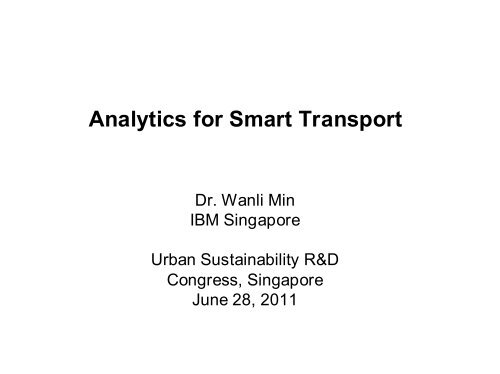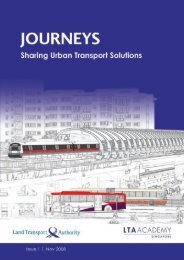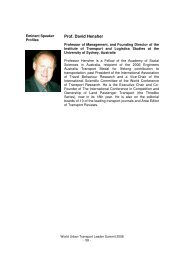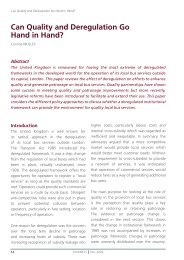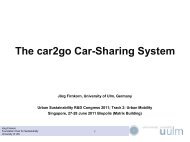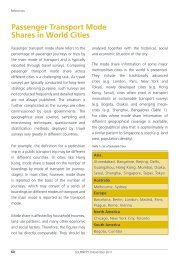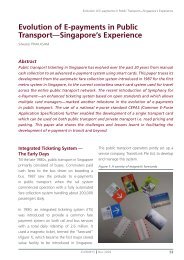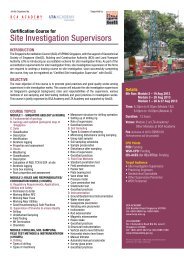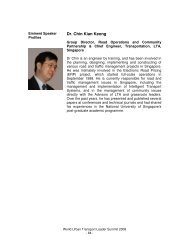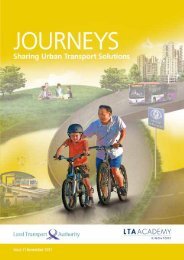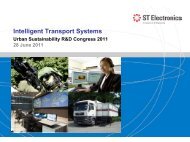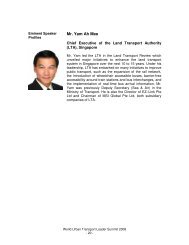Analytics for Smart Transport - LTA Academy - Land Transport ...
Analytics for Smart Transport - LTA Academy - Land Transport ...
Analytics for Smart Transport - LTA Academy - Land Transport ...
Create successful ePaper yourself
Turn your PDF publications into a flip-book with our unique Google optimized e-Paper software.
Intelligent <strong>Transport</strong>ation Systems Initiative<br />
<strong>Analytics</strong> <strong>for</strong> <strong>Smart</strong> <strong>Transport</strong><br />
Traffic In<strong>for</strong>matics<br />
Dr. Wanli Min<br />
IBM Singapore<br />
Urban Sustainability R&D<br />
Congress, Singapore<br />
June 28, 2011
Outline<br />
Intelligent <strong>Transport</strong>ation Systems Initiative<br />
Introduction<br />
Traffic Data Model and Applications<br />
<strong>Analytics</strong> <strong>for</strong> Traffic Data Collection<br />
Conclusion
Intelligent <strong>Transport</strong>ation Systems Initiative<br />
Commonality Across Multiple Fields<br />
新概念<br />
数据流形:交通流,公交车网络,水流,物流,手机塔台,社交网络互动
Intelligent <strong>Transport</strong>ation Systems Initiative<br />
Commonality Across Multiple Fields<br />
• Common challenges on data analytics<br />
• Techniques developed <strong>for</strong> traffic data have interdisciplinary reference value<br />
• Key elements: network structure, dynamic characteristics
Intelligent <strong>Transport</strong>ation Systems Initiative<br />
Introduction<br />
ITS: intelligence vs. in<strong>for</strong>mation<br />
Traffic In<strong>for</strong>matics<br />
– It is all about data<br />
Technology development facilitates data collection<br />
– Video camera<br />
– Loop detector<br />
– On board unit (OBU)
Intelligent <strong>Transport</strong>ation Systems Initiative<br />
• How do we make sense out of massive traffic data ?<br />
• Innovation should not stop with real-time traffic in<strong>for</strong>mation<br />
Data collection<br />
– Where<br />
– When<br />
– What kind<br />
Data Fusion<br />
– Quality assurance<br />
– Data imputation<br />
– Data expansion<br />
Data Model<br />
– Tracking/Incident detection<br />
– Prediction<br />
Application
Intelligent <strong>Transport</strong>ation Systems Initiative<br />
Innovation Concepts – <strong>Transport</strong> In<strong>for</strong>matics<br />
► Issue: strained<br />
infrastructure<br />
More transport capacity is<br />
needed, but construction of<br />
new physical infrastructure<br />
is cost prohibitive, if even<br />
possible<br />
vanpool<br />
3rd train<br />
bus<br />
weather service<br />
vanpool air<br />
taxi probe fleets<br />
historical data incident<br />
loop detectors<br />
floating cell 3 party<br />
video analytics<br />
parking<br />
toll gantry<br />
rd train<br />
bus<br />
weather service<br />
air<br />
taxi probe fleets<br />
historical data incident<br />
loop detectors<br />
floating cell party<br />
video analytics<br />
parking<br />
toll gantry<br />
► Issue: navigating<br />
mass transit<br />
Transit is part of the<br />
solution, but it must be<br />
easier <strong>for</strong> travelers to find<br />
their way and weigh<br />
options<br />
Data Integration<br />
& <strong>Analytics</strong><br />
Focus<br />
► Required Innovation: foundation of data<br />
integration & analytics<br />
• Multiple data sources across transport modes<br />
• Integrated to single foundation of in<strong>for</strong>mation<br />
• Leveraged <strong>for</strong> multiple uses<br />
• Based on open standards<br />
• Integrated systems approach, not point solutions<br />
Traveler<br />
Advice<br />
Network<br />
Response<br />
real-time advice<br />
route planning<br />
personalization<br />
signal timing<br />
transit routing<br />
incident response<br />
per<strong>for</strong>mance<br />
measurement
Intelligent <strong>Transport</strong>ation Systems Initiative<br />
Model-based Data Applications<br />
– Optimal Path<br />
– Future Travel Time<br />
– Seamless Bus Transfer<br />
– Prediction
Optimal Path Given Future Network Traffic<br />
• Take Speed and Volume as example<br />
• With distributional in<strong>for</strong>mation of Speed and Volume over network during<br />
next D time period starting from current moment<br />
• The optimal path from O to D ? Assuming the trip starts after T0<br />
?<br />
• The optimal path starting time (less cost) to reach D be<strong>for</strong>e time target ?<br />
• Introduce link-wise cost, may introduce other Value-at-Risk type of criteria<br />
O<br />
{ ( Vol, Sp) it , | i = 1, LN<br />
, t ∈ ( T0, T0 + D)<br />
}<br />
D
Driver location<br />
Future Travel Time Prediction<br />
Travel time A to B<br />
display board<br />
A B<br />
what will be this driver’s actual travel time if he<br />
starts the journey AB in 3 minutes ?<br />
• The observed travel time is collected AFTER a car has arrived at B.<br />
• The observed travel time of other drivers is past in<strong>for</strong>mation.<br />
• Need a predictive view of future travel time when start from A in 10 minutes.
Predictive Bus Travel Planner<br />
Future bus arrival time, trip duration<br />
When traveling by buses, very often transfer among different service routes are<br />
needed, even so is there might be different connecting bus service routes and<br />
multiple choice of connection bus stops. Passengers need recommendation on bus<br />
travel plan from departure to destination.<br />
Bus A<br />
departure<br />
Knowing predicted arrival of Bus A & B to overlapping stops,<br />
with confidence interval, which stop should the passenger<br />
switch from B to A, with minimum risk (probability of missing<br />
connecting bus) ?<br />
Bus B<br />
Bus B<br />
destination<br />
Bus A
Intelligent <strong>Transport</strong>ation Systems Initiative<br />
Traffic Prediction<br />
Pilot: Singapore’s <strong>Land</strong> <strong>Transport</strong> Authority<br />
Current Status - Volume<br />
Forecast Attribute<br />
Forecast Period
Prediction vs. Broadcasting<br />
Traffic in<strong>for</strong>mation up to now<br />
6:50<br />
6:55<br />
7:00 7:05 7:10 7:15<br />
Current time<br />
Future traffic in<strong>for</strong>mation<br />
7:20<br />
A<br />
B<br />
C<br />
D
Intelligent <strong>Transport</strong>ation Systems Initiative<br />
Pilot: Singapore’s <strong>Land</strong> <strong>Transport</strong> Authority<br />
Current Status - Volume<br />
Forecast Attribute<br />
Forecast Period
Accuracy<br />
0.89<br />
0.885<br />
0.88<br />
0.875<br />
0.87<br />
0.865<br />
0.86<br />
0.855<br />
July 22 2009<br />
Cat<br />
CATA<br />
CATB<br />
CATC<br />
CATD<br />
CATE<br />
SLIP_ROAD<br />
New testing links in CBD Network: Speed Prediction<br />
Accuracy July 19 ~ 25, 2009<br />
10-min 15-min 30-min 45-min 60-min<br />
0.939<br />
0.887<br />
0.876<br />
0.846<br />
0.831<br />
0.919<br />
CATB CATC SLIP_ROAD<br />
Average speed prediction accuracy (zone 1)<br />
10min 15min 30min 45min 60min<br />
0.931<br />
0.875<br />
0.864<br />
0.834<br />
0.82<br />
0.908<br />
0.918<br />
0.874<br />
0.864<br />
0.833<br />
0.82<br />
0.891<br />
0.917<br />
0.874<br />
0.864<br />
0.833<br />
0.821<br />
0.869<br />
0.906<br />
0.873<br />
0.864<br />
0.833<br />
0.821<br />
0.821
Intelligent <strong>Transport</strong>ation Systems Initiative<br />
Innovation starts with Data Quality<br />
Data collection<br />
– Where<br />
– When<br />
– What kind<br />
Data Fusion<br />
– Quality assurance<br />
– Data imputation<br />
– Data expansion
Intelligent <strong>Transport</strong>ation Systems Initiative<br />
Bad Data is Even Worse !<br />
0 50 100 150<br />
0 50 100 150<br />
0 50 100 150<br />
ID 9900020207<br />
0 50 100 150 200 250<br />
ID 9900073805<br />
0 50 100 150 200 250<br />
ID 9903000807<br />
0 50 100 150 200 250<br />
0 50 100 150<br />
0 50 100 150<br />
0 50 100 150<br />
ID 9900020601<br />
0 50 100 150 200 250<br />
ID 9900120301<br />
0 50 100 150 200 250<br />
ID 9903001105<br />
0 50 100 150 200 250<br />
0 50 100 150 200 250<br />
3/10/2007 actual speed (black) vs. historical average speed (blue)<br />
0 50 100 150<br />
0 50 100 150<br />
0 50 100 150<br />
ID 9900063107<br />
ID 9903000201<br />
0 50 100 150 200 250<br />
ID 9903002001<br />
0 50 100 150 200 250
Where to Collect Data ?<br />
13<br />
1<br />
4<br />
2<br />
3<br />
7 8<br />
1<br />
∂ log( V )<br />
max [ W W − W IM( s, T + t)<br />
]<br />
d d<br />
i, T0+ t<br />
∑∑∑ s, t s', t α∑∑<br />
s, t<br />
0<br />
A, d, W | A| d s∈A s'∈ A t= 1 ∂ log( Vs,<br />
T)<br />
s∈ A t=<br />
1<br />
0<br />
IM ( s, T ) is the minimum and sufficient subnetwork representation around link s.<br />
0<br />
A is a set of links, W = [ W ] is a matrix, d is an integer parameter.<br />
st ,<br />
i, T0+ t i, T0+ t T
maximum gain of effective coverage with fixed number of new sensors<br />
smallest number of new sensors to be installed given coverage target<br />
(1, 5)<br />
(2, 5)<br />
OD (5, 12)<br />
Index<br />
1 2 3 4 5 6<br />
Link Index<br />
7 8 9 10 11 12 13<br />
⎡ 1 0 1 0 1 0 0 0 0 0 0 0 0⎤<br />
⎢<br />
0 1 1 0 1 0 0 0 0 0 0 0 0<br />
⎥<br />
⎢ ⎥<br />
⎢ 0 0 0 0 1 0 0 0 0 1 0 1 0⎥<br />
⎢ ⎥<br />
⎣ 1 0 1 1 1 0 1 1 1 0 1 1 0⎦<br />
Main idea:<br />
Construct OD vs link incidence matrix (above), compute Its<br />
reduced row Echelon <strong>for</strong>m (RREF). Replacing entries of “1” by observed traffic<br />
volume, construct a statistically sufficient and irreducible RREF.<br />
Reference Paper: Wanli Min and Ruey Tsay, Statistica Sinica, 303-323, 2005
Intelligent <strong>Transport</strong>ation Systems Initiative<br />
Commonality Across Multiple Fields<br />
• Common challenges on data analytics<br />
• Techniques developed <strong>for</strong> traffic data have interdisciplinary reference value<br />
• Key elements: network structure, dynamic characteristics
Optimal Control Actions<br />
Scenario<br />
- Water pipeline overflow<br />
- Contamination in water system<br />
- Traffic incident on expressway<br />
Optimal Control Actions on demand<br />
- See demo on Google earth<br />
|<br />
© 2007 IBM Corporation
Summary<br />
<strong>Analytics</strong> can help make sense of collected data<br />
- Directly help controllers’ operations (decision support)<br />
- Benefit individual driver / passenger<br />
- More return on the investment of ITS infrastructure<br />
<strong>Analytics</strong> can help determine where to collect data<br />
- Placement of sensors<br />
- Minimum network of sensors to ensure continuity of data-dependent<br />
applications<br />
<strong>Analytics</strong> can help ensure quality of collected data<br />
- Data fusion, anomaly detection<br />
- Missing data imputation<br />
|<br />
© 2007 IBM Corporation
Reference<br />
Nie, Y, M. H Zhang and D H Lee, "Models and algorithms <strong>for</strong> the traffic assignment problem with link<br />
capacity constraints" ,<br />
TRANSPORTATION RESEARCH PART B-METHODOLOGICAL, 38, no. 4 (2004): 285-312<br />
Wanli Min and Ruey Tsay, “On Canonical Analysis of Multivariate Time Series”,<br />
Statistica Sinica, 303-323, 2005<br />
Lee, D H, W Zheng and Q X Shi, "Short-term freeway traffic flow prediction using combined<br />
neural network model“,<br />
JOURNAL OF TRANSPORTATION ENGINEERING-ASCE, (2006): 114-121<br />
Weibiao Wu and Wanli Min, “On Linear Processes with Dependent Innovations”,<br />
Stochastic Process and Their Application, 939-958, 2005<br />
Ben Haaland, Wanli Min, Peter Qian and Yasuo Amemiya. “Statistical Approach to Thermal<br />
Management of Large Data Centers under Steady State and System Perturbations”,<br />
Journal of American Statistical Association (JASA), 1030-1041, Vol 105, 2010<br />
Wanli Min, and Laura Wynter. “Road Trac Prediction with Spatial-Temporal Correlations”,<br />
<strong>Transport</strong>ation Research Part C: Emerging Technology, 606-616, 2011<br />
|<br />
© 2007 IBM Corporation
|<br />
Thanks<br />
© 2007 IBM Corporation


